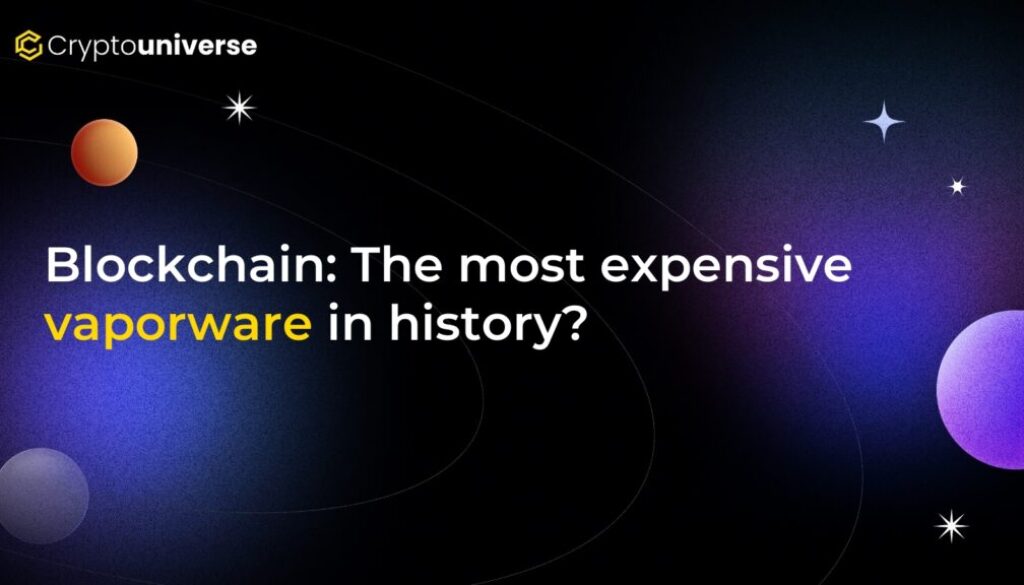Blockchain: The most expensive vaporware in history?

The Broken Promise of a Digital Revolution
In 2008, a figure known only as Satoshi Nakamoto published the Bitcoin white paper, introducing a vision for a new kind of electronic cash system. The dream was simple yet profound: a peer-to-peer network for small, casual transactions, enabling new forms of commerce and freeing money from the control of central gatekeepers. Satoshi even included a poker client in the original code, imagining a world of seamless micropayments where the system “never really hits a scaling ceiling.”
Fast forward to today, and that original vision is almost unrecognizable. Bitcoin, the revolutionary P2P cash system, has been transformed into a speculative Wall Street asset. Giants like Blackrock have entered the fray, and the narrative has shifted from utility to “digital gold”—a playground for high-stakes gamblers. The small, casual transactions Satoshi envisioned? They’ve been relegated to complex, corporate-controlled “Layer 2” solutions like the Lightning Network, adding centralization back into a system designed to remove it.
It’s not just Bitcoin. The broader blockchain industry seems to have lost its way. Ethereum, despite years of development and countless updates, remains a tangled web of sidechains, bridges, and scaling solutions that still struggle with high fees and congestion. After over a decade and tens of billions of dollars invested across the industry, where is the killer app? Where is the mainstream adoption? The silence is deafening.
Why Did Blockchain Fail to Deliver?
The battlefield is littered with the ghosts of failed projects and broken promises. Enterprise blockchain initiatives like IBM’s Hyperledger, once hailed as the future of industry, are now cautionary tales with little to no real-world adoption. So, why has the industry fallen so short of its potential? The reasons are as frustrating as they are clear.
1. Speculation Replaced Utility
The single biggest setback was the tidal wave of greed that washed over the industry. Capital flows where it’s incentivized, and for the last decade, the greatest financial returns came not from building useful applications, but from simply holding assets like BTC and ETH. Why build a world-changing dApp when you could see 100x returns just by HODLing? This speculative frenzy created massive bubbles around “vaporware” projects that had no users, no developers, and no future, yet reached multi-billion dollar valuations.
2. A Fragmented and Broken Ecosystem
Instead of a single, unified network where applications could interoperate and share liquidity, we got a fractured mess. Today, thousands of blockchains exist in their own isolated silos. DeFi, gaming, and social media apps are scattered across hundreds of chains, none of which can communicate with each other seamlessly. Even within a single ecosystem like Ethereum, popular apps exist on different Layer 2s, forcing users to navigate a complex and costly maze of bridges, each with its own fees and security risks.
3. An Unforgiving User Experience (UX)
Perhaps the most critical failure is the user experience. The best technology in the world will fail if people can’t easily use it. The current state of crypto is a UX nightmare. Managing wallets, safeguarding seed phrases, understanding gas fees, and using cross-chain bridges is a daunting task even for technically savvy individuals. For mainstream adoption, this is a non-starter. You can’t expect your grandmother to bridge assets from Polygon to Arbitrum just to try a new app.
Returning to the Original Blueprint: A Path Forward
With retail users alienated, no mainstream applications, and a growing reputation as a solution in search of a problem, it’s easy to believe that blockchain is the most expensive <vaporware> in history. But it didn’t have to be this way, and there is still time to turn the ship around.
The solution isn’t another new, hyped-up protocol. The solution is to return to the original. BSV (Bitcoin SV) is the only blockchain that strictly follows Satoshi Nakamoto’s original design, protocol, and vision. By restoring the original Bitcoin protocol, BSV has unlocked the properties that the rest of the industry has been chasing for years: unbounded scale, microscopic fees, and immense data-handling capabilities.
These aren’t just promises; they are demonstrable facts. Thanks to its architectural design and recent updates like Teranode, the BSV network has already proven its ability to process one million transactions per second. More importantly, it does so while keeping fees stable at fractions of a penny. You can verify this data for yourself on a block explorer like WhatsOnChain. This is the “no scaling ceiling” Satoshi wrote about—a single, global public ledger capable of handling enterprise, consumer, and micropayment transactions for the entire world.
Let’s Build the Future, Together
If the blockchain industry is to become more than a failed experiment, the tribalism and wishful thinking must end. It’s time to rally around the technology that works today, not the one that might work five years from now after another dozen upgrades.
The BSV ecosystem is already demonstrating what’s possible, with a growing list of applications in cybersecurity, supply chain management, Web3 gaming, and more. Imagine what could be achieved if the immense talent, energy, and capital currently spread across thousands of dead-end projects were focused on a single, scalable protocol.
The choice is ours. We can continue spinning our wheels, or we can embrace the one protocol that can serve as the backbone for everything we were promised. The tools are here. It’s time to build on BSV.


